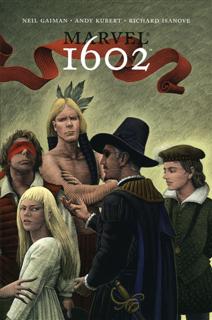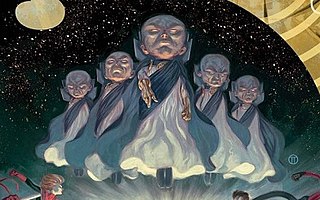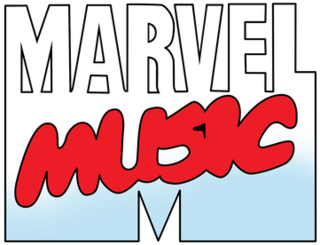Plot
All over Europe, strange weather provokes panic, with many believing that the unnatural occurrences are the beginning of the Apocalypse. Dr. Stephen Strange, the court physician of Elizabeth I, senses that there are unnatural forces at work. He has also been asked to watch over the secret treasure of the Knights Templar which is being brought to England from Jerusalem. Elizabeth tasks her head of intelligence, Sir Nicholas Fury, to bring the treasure—believed to be a weapon—to England safely. Fury in turn contracts blind minstrel and agent Matthew Murdoch to rendezvous with the Templar guard somewhere in Europe and secure the weapon. Later that evening, Fury and his assistant Peter Parquagh are attacked by an assassin whom Fury disables and locks in the Tower of London.
Meanwhile, the ship Virginia Maid arrives in England from the New World, carrying the young Virginia Dare, the first child born in Roanoke colony, as well as her Native American bodyguard Rojhaz. They are taken to meet the Queen only for a second winged assassin to snatch Virginia. Rohjaz quickly disables the attacker, but not before Virginia transforms into a white gryphon. Rojhaz subdues Virginia, and Strange bespells her to human form before Fury sees her. Dare's powers cause Strange to suspect that she is the cause of the disastrous weather. Fury interrogates the imprisoned assassin to learn who sent him. He is told that it is Count Otto von Doom, ruler of Latveria, but Fury is too late to stop one of Doom's machines from killing Elizabeth with a poison gas released by dropping a pill into aqua regia.
Upon Elizabeth's death, James VI becomes ruler of both England and Scotland. James is distrustful of "witchbreed", those with magical or uncanny powers, and collaborates with Spanish High Inquisitor Enrique to blame the witchbreed of England, headed by Carlos Javier, for Elizabeth's death. Fury, a friend of Javier and his students, is forced to take the witchbreed to the Tower. Strange, Javier, and Fury meet and discuss how to save the world; an act which will almost surely lead to them being branded traitors by James. Strange learns that Natasha, a fellow agent, has betrayed Murdoch and the Templar agent Donal to Doom. Strange also learns that Doom has been holding captive four heroes from the ship Fantastick, including Fury's friend Sir Richard Reed. Javier agrees to help Fury, and the party sets out on a ship levitated by Javier and his page John Grey across the continent.
Strange meanwhile finds himself on the moon where he meets the Watcher Uatu, who tells him that the strange events are due to an anomaly he calls the Forerunner. The Forerunner is from the future and its presence in the past has disrupted reality to the point of impending annihilation of not only Strange's world but all other universes as well. Explaining his theory that the emergence of various superhumans on Stephen's Earth four hundred years before their season is the result of the universe trying to save itself, the Watcher tells Strange that he will not be able to repeat what he has learned while he lives.
Fury, Javier, and his students launch a successful attack on Doom's fortress; John Grey, revealed to be female, dies from her exertions in keeping the ship intact. The Four of the Fantastick are freed, and Doom is horribly scarred when lightning strikes a golden ball that he believes is the Templar's treasure. In fact, the true treasure is Donal's walking stick, which when struck on the ground transforms into the hammer Mjolnir and Blake into the Norse god Thor. The ship of fugitives heads for the New World. In Spain, Enrique is exposed as both a witchbreed and a Jew, and sentenced to be burned at the stake with his young acolytes, Petros and Sister Wanda. Using his powers, Enrique frees himself and his acolytes, and they escape on a ship of their own, also bound for America.
Strange is executed by James, who is furious that Fury and the witchbreed escaped him. Now no longer constrained by the Watcher's oath, Strange communicates telepathically with his wife Clea. He informs her that the Forerunner is the cause of the anomalies and that universal salvation depends on its transport back to its time; she takes his head from its pike at the Tower of London and sets off for America with Virginia and Rojhaz. Clea voices her opinion that Strange's suspicions were wrong, and that the Forerunner is not Virginia. Rojhaz confirms this, revealing himself to be Steve Rogers. After fighting against a 21st-century dictatorship led by a President for Life, Rogers was captured and sent back in time so as to completely erase his legacy. He was taken in by Native Americans who misheard his name; upon encountering the struggling Roanoke colony, he helped it survive and became Virginia's bodyguard.
Fury and company arrive at the Roanoke colony, where they discover the rift through which Rogers arrived. Javier senses three ships incoming: the Virginia Maid, Enrique's ship, and a ship carrying James's agents, among them his advisor David Banner and Parquagh, who has been coerced into loyalty. Realizing that the rift is radiating "galvanic" energy, Javier enlists Enrique to manipulate the rift in exchange for an unspecified boon. Donal summons Thor once more, enabling the necessary input of energy to open the rift again. On the beach, Fury kills all of James's agents except for Parquagh and Banner. In England, Murdoch threatens James with death should he harm Fury. Rogers refuses to go back through the rift, hoping to build a better America. Fury incapacitates him and carries the body back through the rift, thus going into the future himself.
The rift and the universe restore themselves, meaning the destruction of the alternate timeline; however, Uatu the Watcher is granted a "pocket universe" by his colleagues in which the 1602 timeline remains intact, and where the powered fugitives decide to settle in the Roanoke colony, declaring it a free place for all. Meanwhile, while walking in the woods with Virginia, Peter is bitten by a spider exposed to the energies released when Rojhaz and Fury entered the rift. Banner, who shielded Peter from the energies, has changed into a hulking gray monster. Intrigued by the continuing events, Uatu continues to watch the new universe (later designated Earth-311).

















